If you love orchids but the thought of high maintenance has deterred you in the past, the beautiful Cymbidium is a spectacular genus of orchids that are a lot easier to grow and care for.
They are one of the oldest horticultural orchids in the world and the genus is now one of the most popular in cultivation. They feature highly decorative and colourful flower spikes, fleshy lime-green leaves and arching, strappy foliage that appears in a welcoming relaxed form.
Here is your full guide to growing and caring for this spectacular genus of orchids.
More...
Family: | Orchidaceae |
|---|---|
Genus: | Cymbidium |
Species: | Many available |
Common Name: | Boat orchids |
Location: | Indoor and outdoor (potted) |
Type: | Evergreen flowering plants |
Growth: | 50cm to 100cm tall, 60cm to 80cm wide (depending on species) |
Sun requirements: | Bright, indirect filtered light |
Foliage Colour: | Green |
Flower Colour: | Varies depending on the species |
Flowering: | Winter and Spring |
Maintenance level: | Medium |
Poisonous for pets: | Toxic to cats and dogs only if ingested |
Introducing Orchid Cymbidium
These particularly ornamental orchids are famed for their impressive influence indoors but they also like to spend some of their time outdoors. They are hardy orchids, being easy to grow in most regions of Australia and they generally only require basic attention and care.
Enjoy stunning winter flowers for up to 3 months each year in shades of white, yellow, peach, burgundy, pink, hazel or even green.
There are many decorative species and varieties to choose from that can each add their own charm so, you’re bound to find the perfect pick for your home.

The Cymbidium genus, also known as boat orchids, consists of about 55 species of evergreen flowering plants in the orchid family, Orchidaceae. There are a further 16 natural hybrids as well as many cultivated varieties from modern breeding, each sporting its own flower colour and uniqueness.
Cymbidium is native to the subtropical and tropical regions of Asia and Australia, where they thrive in moderate climates. They are medium-growing plants, taking about 2 to 3 years to mature before flowering.
Boat Orchid Growing Habits
In cultivation, they usually grow to 50cm to 100cm tall and 60cm to 80cm wide, depending on which species you choose. They do their best potted in tall containers but they can also be hung in large baskets for a more cascading effect.
The cut flowers will also look fantastic in floral arrangements around the house, adding long-lasting spectacular colour and variation to your vases.
Foliage can be mildly toxic to pets if ingested so be sure to place your plant accordingly if you’re concerned about your fur baby munching on the leaves.
Most Popular Australian Cymbidiums
Channelled Boat Lip Orchid (Cymbidium canaliculatum)
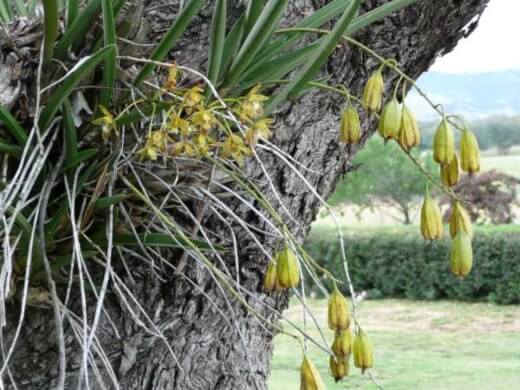
Source: oznativeplants.com
Known as the channelled boat-lip orchid, this species is endemic to New South Wales and the northern parts of Western Australia. It is a clump-forming plant featuring up to 60 fragrant variegated flowers in olive green, yellow-brown and purple with small blotches of white.
The lime-green leaves are deeply channelled and curvy, adding to the ornamental qualities of this beloved native orchid. This species grows to around 80cm to 120cm tall and about 40cm to 50cm wide.


Get Your Free Guide:
Master Growing Australian Natives eBook
A Must Have Complete Guide for Every Australian Garden
Get Your Free Guide:
Master Growing Australian Natives eBook
A Must Have Complete Guide for Every Australian Garden
Snake Orchid (Cymbidium suave)
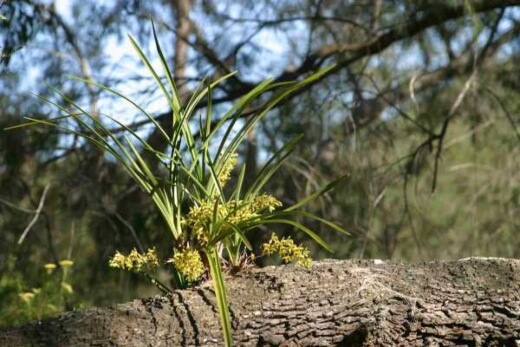
Source: oznativeplants.com
Commonly referred to as snake orchid, this species is endemic to eastern Australia. It produces long-lasting clumps of grassy green leaves and up to fifty fragrant olive green to mustard-coloured flowers atop gently arching flowering stems.
It also grows to around 80cm to 120cm tall and about 40cm to 50cm wide in cultivation. Thanks to its fleshy foliage, this species is perfect for draping in hanging baskets and it offers more yellow tones to indoor spaces.
Giant Boat Lip Orchid (Cymbidium madidum)
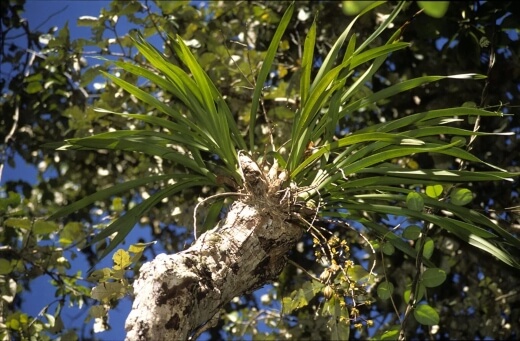
Source: orchids.fandom.com
Known as the giant boat-lip orchid, this species is widely distributed in eastern Queensland and north-eastern New South Wales. It features more strappy, thin leaves that shimmer with light-green hues.
It can produce up to 70 olive green flowers with petals that form in a forward-leaning fashion. The arching flowering stems look fantastic potted in tall containers around the house, adding luxurious lushness to any indoor or outdoor setting.
Cymbidium Lancashire Ruby Paradisia
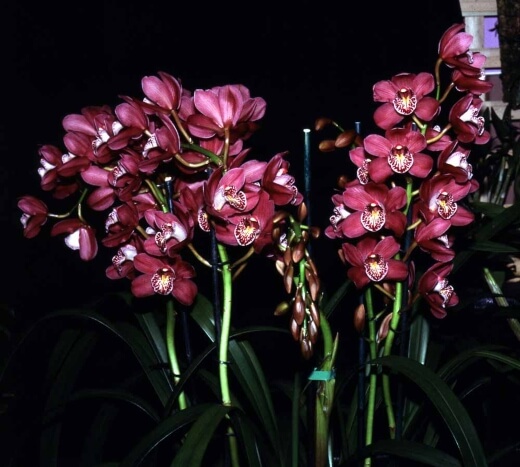
Source: oscov.asn.au
This prolific flowering cultivar features rosy-purple to mauve flowers with white blotches. It is the perfect pick for adding a more tropical influence to your indoor spaces.
Cymbidium Trinity Gold

Source: royaleorchids.com.au
This cultivar produces larger flower spikes that radiate brilliantly with yellowy-golden hues. They can be hard to come by but if you manage to find one, this cultivar can certainly impress in any setting.
Cymbidium Valley Freestyle Heaven Scent
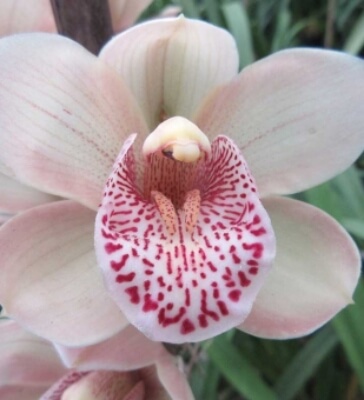
Source: indiabizclub.com
As suggested by its name, this cultivar's flowers have an extremely welcoming and pleasant scent. They are born with a light-pink colour and mature to a deeper burgundy with white fluffy tips.
There are many other gorgeous varieties and cultivars available depending on your area, so be sure to chat to your local garden centres or nurseries to see which cymbidiums they may have in stock.
How to Grow Orchid Cymbidium
As with most orchid species, growing these plants from seed is not recommended as the process requires a heavy investment in time, patience and skill.
Even if you can get it right, seeds can take 2 years or longer to show any signs of growth and it could take a further 8 years before your seedling grows big enough to produce blooms.
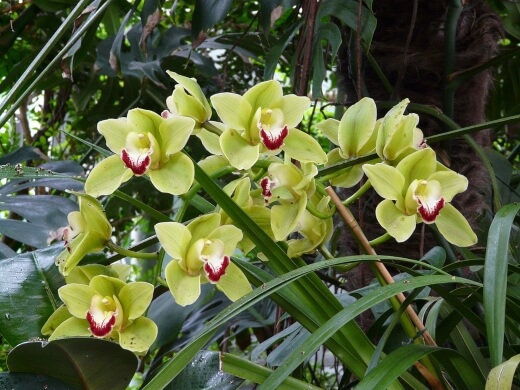
Cymbidium Propagation
Luckily, you can easily propagate cymbidium orchid using division as these plants are quite forgiving. Alternatively, young and healthy plants should be readily available at your local nurseries or garden centres.
These nursery plants will take far quicker to flower and they are a lot easier to establish in your desired growing location.
Propagating Orchid Cymbidium Using Division
- Larger specimens will always need to be repotted every couple of years so during this time, immediately after flowering, you can propagate a disease-free plant.
- Gently lift the orchid from its current container to expose the root system.
- Using a sharp and clean pair of secateurs or a shovel or spade, cut right through the root mass to divide the plant. (Check out these premium pruning shears for reference).
- Depending on the size of the plant, you can cut it into 2 to 4 pieces. Be sure to divide the plant so that the smaller sections are a decent size for repotting to ensure good flowering next season.
- Each newly divided clump should have at least 3 to 4 bulbs with leaves and a few leafless bulbs as well.
- Remove any damaged or dead parts from the clumps, including any dry, thinning roots.
- Replant each new clump into fresh orchid potting mix and water in lightly.
- After a few weeks, once the newly divided plants have started to settle in the new container, you can add a small amount of fertiliser to encourage new roots.
Tips on Establishing Nursery Plants
- Young orchids from a nursery may need a little extra protection as they settle in their new environment at your home.
- Place new nursery plants in a sheltered position indoors for the first few weeks, away from any strong winds, drafts, harsh light or frost.
- Mist them occasionally to help with humidity and prune away any damaged parts.
- After about a month, you can move them around as needed to allow them to get the right amount of light and water they need to grow and flourish.
Best Conditions for Growing Cymbidium Orchid
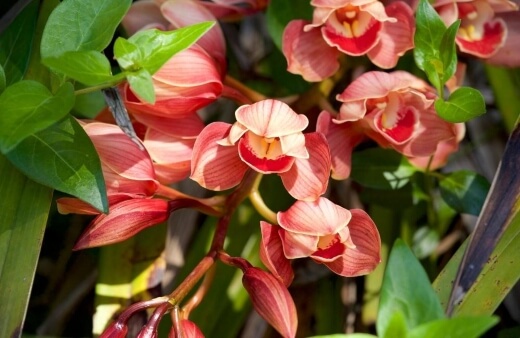
Being winter bloomers, you can plant orchids almost any time of the year. For younger plants, planting in spring or autumn is recommended to avoid the hottest and coldest times of the year.
These hardy orchids are however sensitive to strong winds so be sure to position them accordingly.
Lighting for Boat Orchids
Lighting is the most crucial factor for orchids. Your plant will thrive in good, filtered light or indirect sun for half of each day. Only in the colder months can you expose it to more full sun to encourage flowering as these plants do enjoy the gentle winter sun.
Too much shade will create attractive darker green foliage but with no flowers. On the other hand, too much sun can quickly bleach the leaves, causing them to yellow and burn.
Orchids don’t respond well to any direct summer sun. Use your leaves as an indicator to see if the lighting is optimal by aiming for mid to light-green leaves.
Ideal Soil Conditions
As with most orchids, using a premium orchid potting mix with large chips of bark should be perfect. Orchid mixes ensure excellent drainage so be sure to also always use containers with fast drainage for the best results. These plants don’t enjoy sitting with wet feet.
Orchid Cymbidium Care Guide
Caring for orchids will always be a little intensive but luckily, orchid cymbidium is far less demanding overall. Here are our tips for caring for cymbidium to ensure it thrives and flowers best.
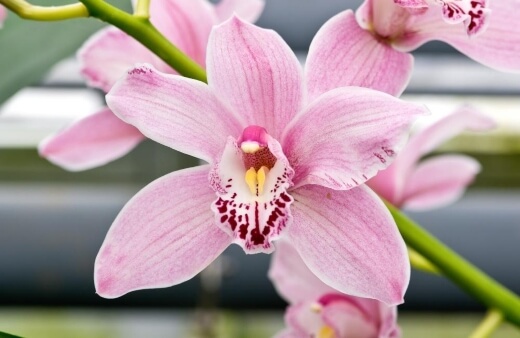
Boat Orchid Watering Schedule
Water sparingly in winter as rain should be enough. Water when the soil has been dry for more than a week in general. In the summer months, you should water about 3 times per week and in very hot and dry conditions, daily watering may be needed.
Fertilising Needs
There are two main growing seasons for orchid cymbidium. For healthy leaf growth in summer, the plant will need lots of nitrogen so feed with a fertiliser high in nitrogen (the N ratio in NPK).
After summer, you can cut back on the nitrogen and feed your plant with more potash (potassium) to encourage more prolific flowering. After flowering, you can feed with some high-quality orchid food once.
In general, a balanced liquid fertiliser applied at half strength can be used for the other periods of the year if your plant needs it.
Improving Flowering
Orchid cymbidium will need a clear distinguishing difference between day and night to flower best. Try to avoid deeply shaded positions and cold night temperatures.
When flowering, bring your plant indoors for the best results. However, these plants are not suited for permanent indoor positions so, after flowering, your plant will need some indirect light outdoors to refuel its processes.
Be sure to also cut off old flower spikes straight after flowering.
Is Pruning Needed?
Pruning may not be needed for most periods of the year. Prune lightly as needed only to remove damaged or dead foliage and old flowers in spring to early summer.
For more pruning tips, see our guide on pruning Australian native plants.
Repotting Boat Orchids
Repotting should not be done too often as these plants do enjoy sitting tightly snug in their pots. They also flower best if not disturbed annually. Your plant will need to be repotted every 3 years or so when the roots become overly compacted.
When repotting, you can divide the plant into large clumps and repot each clump. Alternatively, you can simply repot into the next container size.
Possible Boat Orchid Pests & Diseases
Few pests and diseases trouble these hardy orchids when they’re grown in good conditions. But in many cases, they can suffer from a few nagging issues.
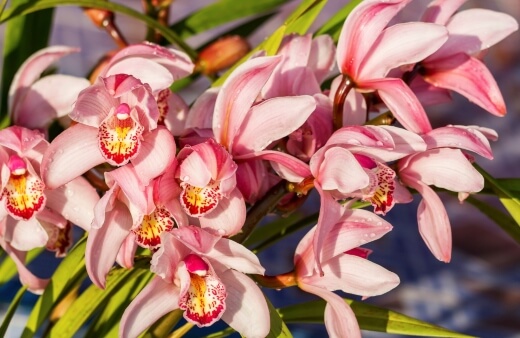
Scale Insects/Aphids/Spider Mites/Mealybugs
These smaller sap-sucking insects can be a nuisance, especially for indoor plants. Luckily, they can all be treated quite easily by using neem oil which you can spray into the foliage and on the flowers.
Apply your non-toxic neem oil every couple of weeks to get rid of infestations. Alternatively, you can also use a mixture of soap and water to spray and knock them off the plant.
Snails/Slugs/Caterpillars/Beetles
These larger pests can be attracted to the scented flowers and foliage. They will chew away at the leaves and stems and in severe cases, they can cause some serious damage.
Luckily, they are far easier to identify. If you see your foliage has been eaten away, these guys are probably the cause, especially overnight outdoors. To get rid of them, you can also apply good eco-neem oil or pest control pellets to deter them.
Bring your plant indoors overnight while treating to avoid them from coming into further contact with your plant. You can also remove them by hand using gloves and dispose of them elsewhere.
Orchid Cymbidium Frequently Asked Questions
What month do cymbidium orchids flower in Australia?
The most commonly grown species will bud in winter and flower from May through to August and September. The flowers are long-lasting and each species can produce a different amount of flower spikes.
What is the best potting mix for cymbidium orchids?
Most orchid enthusiasts will recommend using a mixture of bark, perlite, coconut coir and other loose organic material for these orchids. A commercial orchid mix should be able to serve your plant very well.
When should I buy cymbidium orchids?
Most nurseries stock these spectacular plants between November and March.
Why is my cymbidium not blooming?
Excessive shade will quickly cause these orchids to become non-flowering, more dormant versions of themselves. Be sure to move your plant into more filtered light or even full winter sun for half of each day to encourage more blooms next season.
If you’re a fan of flowering plants and want to establish more in your home or garden, why not check out our informative guide below for our best native picks:

Spruce Up Your Home with the Spectacular Orchid Cymbidium
A perfect pick for those who love orchids but don’t want to deal with high-maintenance demands, the Cymbidium genus consists of many highly decorative flowering plants that can quickly add tropical life to your living spaces.
With their striking flower spikes and relaxed and lush foliage that arches gently, boat orchids are truly ornamental additions to any setting.
With many beautiful native varieties to choose from as well as many exciting cultivars out there, there’s bound to be the perfect orchid cymbidium for your needs.
Published on July 27, 2022 by Lorri Hopkins
Last Updated on February 22, 2025




